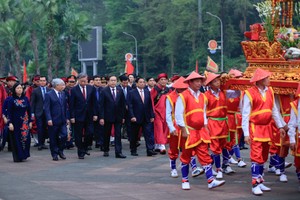HCMC has spent over VND20 trillion (US$900 million) to deal with flooding but worsening flooding after heavy rains has proved the city’s efforts ineffective. Experts attributed the issue to outdated and short drainage system, climate change and rampant urban construction.

The city started construction of drainage systems in the valleys of Nhieu Loc-Thi Nghe, Tau Hu-Ben Nghe and Tan Hoa-Lo Gom Canals ten years back to solve flooding.
Right after the first sewers were installed, many scientists and experts from authorized agencies found that their size soon outdated and unsuitable with complicated weather condition.
They have been designed to drain floodwaters from rains with the precipitation of 75-92mm during three consecutive hours. However, the rainfall of 100-150mm has occurred more regularly.
On September 26 this year, a 204mm downpour submerged nearly 60 streets under half a meter of floodwater. This appeared to fail HCMC’s VND20 trillion efforts to cope with flooding.
The first phase of Nhieu Loc-Thi Nghe cleanup project has completed with the total cost of $200 million. The second phase has been implemented with the total funds of $450 million.
VND6,043 billion has been spent on the first phase Tau Hu-Ben Nghe cleanup project and the second phase covering Doi-Te canals needs VND11,282 billion.
Associate professor Ho Long Phi, head of the Water and Climate Change Institute under the HCMC National University, said that four local and foreign consultancy agencies had studied and consulted for the city about sewer design standards of the above projects.
The international agencies include Japanese PCI, U.S. CDM and Belgian Black and Veatch. The local agency is the Southern Hydrometeorology and Climate Change Sub-Institute.
At that time, they based on statistics on rains from 40 years back to give the design standards.
During 40 years from 1962 to 2001, HCMC saw only nine rains with the precipitation of over 100mm. It has increased to 30 rains from 2002 to 2016.
In addition, high tides have contributed to flooding. The tide level was below 1.50 meters during 17 years from 1990 to 2007. Since 2008, it has regularly topped the third alarming level of 1.5 meters.
The record high level was seen from 2011-2015 when the level touched 1.6-1.68 meters.
Moreover, the combination between heavy rains and tides has worsened inundation in many areas. Tide peak was 1.3-1.68 meters in combination with 30-143mm rainfall from 2011-2015.
After recognizing outdated danger of the new sewer system, some experts proposed to change the design to make it more suitable.
However because most environmental and anti flooding projects of the city have been funded by official development assistance (ODA) loans with complicated loaning procedures and bid invitation. Adjustments would be very time consuming.
Besides, anti-flooding projects have run behind schedule because of many reasons. Some experts said that the city should not worry about heavy rains because they were just sudden.
These all have sent HCMC to not adjust the sewer design.
Most of the city’s old sewers have been able to serve 30-40mm rains but their capacity has been affected with depression and garbage.
Anti-flooding not abide by plan, go back up nature
Mr. Hoang Minh Tri, deputy head of the HCMC Institute on Development Study, said that HCMC’s terrain is high in the north and slopping down to the south. The height difference between the two areas is up to 3-4 meters at some places.
Many spots in northern districts such as District 12, Go Vap, Hoc Mon and Cu Chi locate 6 meter higher than the sea level while the altitude is only one meter in southern Districts 7, Binh Chanh, Nha Be and Can Gio.
With that natural terrain, the southern area has long been the city’s main drainage direction.
However it has been affected with the city’s policy to develop sea economics towards the south, where is home to Saigon Port, Tan Thuan Export Processing Zone and Phu My Hung New Urban Area.
When the policy was announced many years ago, environmental experts worried that it would block the city’s drainage way.
So HCMC tasked Tan Thuan Industrial Development Company to build an urban development plan for the entire area. The company had organized an examination and selected U.S. SOM to consult for it to build the plan.
Mr. Hoang Minh Tri, one of experts assessing the plan, said that the consultant required the city to protect rivers, canals and alongside green areas when developing the southern part of the city to ensure drainage capacity.
The plan was approved by the Prime Minister in 1994 and won a prize in Asia for its natural adaptation design.

Years later, Mr. Tri visited the area and found its development has not abided by the plan. Many canals have been filled up, green areas have no longer existed and houses have been built close together.
If the plan had been implemented seriously, flooding would not be as serious as present, said Mr. Tri.
According to the city’s plan by 2020, three satellite towns will be built with full technical and social infrastructure to ease pressure the center of HCMC.
So far the towns have not been formed while urban development has been like an oil slick. Residential areas follow each other closely and gradually encroach natural drainage ways.
The oil slick development with a shortage of technical infrastructure including the drainage system has caused the unavoidable flooding.
Mr. Do Tan Long, head of the Drainage System Management Division of the HCMC Steering Center for Urban Flood Control Program, said that HCMC’s drainage system is short, overloaded and managed by many agencies.
The center is in charge of about one third of the total sewer length of 3,099 kilometers. The remaining sections go to local authorities and the Management Board of Environmental Improvement projects.
By 2020, HCMC needs to have 6,600 kilometers of types of sewers to tackle flooding but only 43.22 percent have been built so far. Budget difficulties have hindered the city from constructing the remaining of 3,407 kilometers.
























